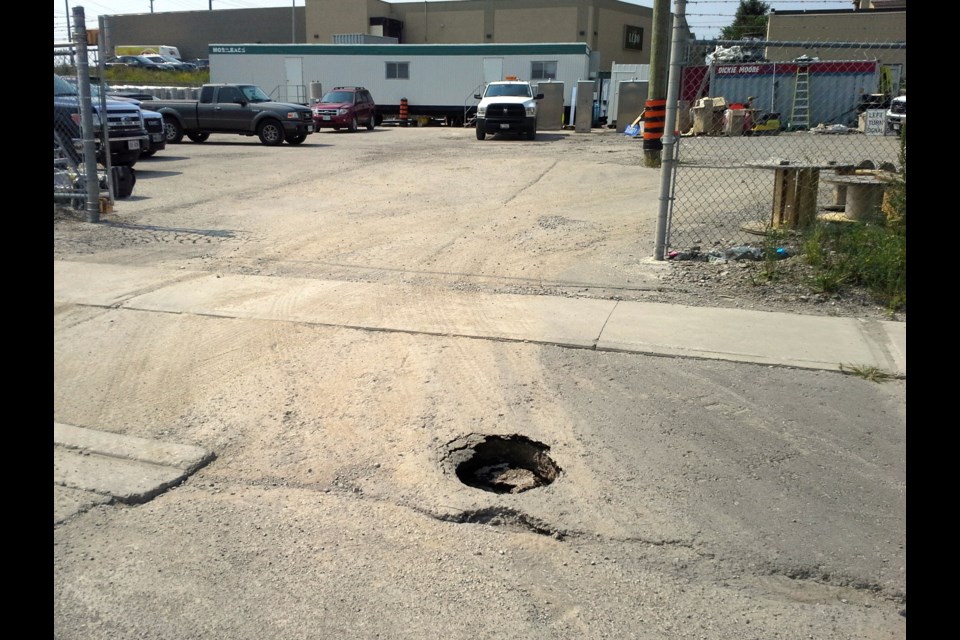Rejoice. That pothole that rocked your world this week means that spring has definitely sprung in Newmarket.
It’s no coincidence that CAA launches its Worst Roads campaign in the spring, when parts of the roadways seem to implode overnight and bumpy rides are on drivers' minds.
In 2018, Town of Newmarket public works services staff filled 3,468 potholes during the first year it began tracking repairs. And spring is the busiest time for filling in the pesky craters that can send you to the mechanic for a front-end alignment, new tires and rims.
So, why do potholes seem to spring up as soon as winter releases its icy grip?
“Potholes occur when snow and ice melt as part of seasonal freeze-thaw cycles,” public works services director Chris Kalimootoo said. “The resulting water from the melt seeps beneath the pavement through cracks caused by the wear and tear of traffic. As the temperatures cool to below the freezing mark at night, the water becomes ice and expands below the pavement, forcing the pavement to rise. “
As the weight of traffic from cars continues to pound on this raised section, and the temperatures once again rise above freezing, a shallow divot occurs under the surface and the pavement breaks, forming a pothole, he added.
More significant potholes usually occur on local roads with higher traffic volumes such as roads maintained by York Region, including Davis Drive, Yonge Street, Mulock Drive, Bayview Avenue, Leslie Street and Yonge Street.
Town crews have already begun repairing potholes, at a cost of about $35 to $50 depending on size.
Typically, potholes are repaired by cleaning out the loose debris, making sure as much of the moisture is dissipated from the area as possible and filling it with a hot or cold asphalt patch, Kalimootoo said. A cold patch is used most frequently as it is the quickest and most available during the freeze/thaw cycles when potholes are more abundant.
Still, residents express frustration to the town about such things as why potholes keep returning year after year, why they can’t be permanently fixed, and why some seem to take longer than others to be repaired.
Kalimootoo said his department works to repair all reported potholes within timeframes set out by the provincial minimum standards guide, which dictates how quickly a pothole should be repaired depending on the size of the pothole and the class of the road.
Speaking of size, a distant cousin to the pothole is known as a sinkhole, which is usually much bigger and can cause more issues for those using the road.
“A sinkhole is usually caused by the road base materials evacuating due to a water main break, flash flooding or a hole in the infrastructure that allows the material to escape through,” Kalimootoo said.
You’ll likely see a sinkhole make the local news. But for potholes, the town advises you to report their exact location if they are significant in nature, about 8 centimetres in depth or the size of a laptop bag.
Here’s how you can report a pothole:
- Call the Town of Newmarket at 905-895-5193 with specific information on the location of the pothole.
- Email [email protected] with specific information on the location of the pothole
- Report a problem, including sending a photo of the pothole, through the My-Waste and Recycle Coach app which can be downloaded from the App Store
- Potholes on primary York Region roads such as Mulock Drive, Bayview Avenue, Leslie Street, Davis Drive, Yonge Street etc., can be reported to York Region at [email protected]
Tips to avoid pothole damage to your vehicle:
- It’s important that you drive properly around them. Slowing down before you reach the pothole will help to minimize the damage done. This will prevent your vehicle from tilting forward too much and causing serious impairment to the front of your vehicle.
- Change lanes whenever possible to avoid any potholes. The fewer you go over, the less likely you will damage your vehicle so do your best to avoid potholes altogether.
- Make sure your tires are properly inflated. If they aren’t, you run the risk of them popping when running through a pothole. You should always check your tires before you enter your vehicle as there could be damage that you’re not aware of.
- Potholes are more dangerous during and after it rains, so remember be extra careful. It’s hard to tell what’s underneath a puddle, so make sure you go extra slow if you suspect there are potholes in the area.



